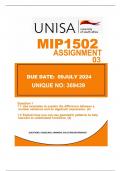,MIP1502 Assignment 3: Unique number: 369439
Due date: 09 July 2024
Question 1
1.1 Use examples to explain the difference between a number sentence and
an algebraic expression. (4)
A number sentence is a mathematical statement that uses numbers and
symbols to show a relationship between them, often involving operations like
addition, subtraction, multiplication, or division.
For example, "3 + 5 = 8" is a number sentence because it shows the
relationship between the numbers 3, 5, and 8 using addition.
On the other hand, an algebraic expression is a mathematical statement that
includes variables, numbers, and operations. These expressions can represent
relationships or patterns, and the variables can take on different values.
For example, "2x + 4" is an algebraic expression because it includes the
variable x along with the numbers 2 and 4, and it represents a relationship
that can change depending on the value of x.
In summary, a number sentence is a statement using only numbers and
operations to show a specific relationship, while an algebraic expression
includes variables, numbers, and operations to represent more general
relationships or patterns.
References:
- Math Open Reference. (n.d.). Algebraic Expressions. Retrieved from
https://www.mathopenref.com/algebraicexpressions.html
, 1.2 Explain how you can use geometric patterns to help learners to understand
functions. (4)
Geometric patterns can be used to help learners understand functions by:
Identifying rules: Geometric patterns can be used to identify rules and
relationships, such as linear or quadratic relationships, which are fundamental to
understanding functions.
Exploring transformations: Geometric patterns can be transformed in various
ways, allowing learners to explore how functions can be transformed and
manipulated.
Developing algebraic thinking: Geometric patterns can be used to develop
algebraic thinking by encouraging learners to describe patterns using variables
and equations.
Geometric patterns can be used to help learners understand functions by visually
displaying how different variables interact with each other. For example, by using
graphs to represent functions, learners can see the relationship between input
and output values in a clear and structured way.
Geometric patterns can also be used to demonstrate how changes in one
variable affect the overall shape of a function, such as shifts, stretches, and
reflections.
Moreover, geometric patterns can help learners to identify key features of
functions, such as intercepts, turning points, and symmetry. By analyzing the
geometric properties of functions, learners can deepen their understanding of
how functions behave and make predictions about their behavior.
Reference:




